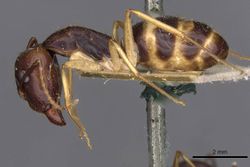Key to Camponotus maculatus species complex in the New World
This worker key is based on: Mackay, W.P. & Delsinne, T. 2009. A new species of carpenter ant from Paraguay, with a key to the New World members of the maculatus species complex. Sociobiology. 53:487-498.
The following key will separate the majors and often the minors of the New World members of the maculatus species complex:
You may also be interested in Camponotus
1
- Cheek and shaft of scape lacking erect or suberect hairs (rarely 1 or 2 may be present on cheek near base of mandible, and even on shaft of scape, especially in specimens from the Carribean) . . . . . 2
- Cheek with erect or suberect hairs, at least near base of mandible; shaft of scape often with erect hairs . . . . . 6
2
return to couplet #1
- Antennal scape of major extending well past posterior lateral corner; widely distributed and common . . . . . 3
- Antennal scape of major barely reaching posterior lateral corner; known only from type locality in Rondonia, Brasil . . . . . Camponotus abunanus
3
return to couplet #2
- Florida, Mexico, south to Brasil . . . . . 4
- Washington, Oregon and Hawaii . . . . . Camponotus maculatus
4
return to couplet #3
- Head of minor (above it is written that the key will allow to separate majors. not noticeably narrower posteriorly (except posterior to eyes); widely distributed from Florida south to southern Brasil, not reported from Paraguay . . . . . 5
- Head of minor noticeably narrowed posteriorly; known only from Paraguay . . . . . Camponotus taniae
5
return to couplet #4
- Mostly brown, gaster usually with lateral yellow splotches or transverse bands on each tergum; USA (Florida) south to Brasil, Caribbean . . . . . Camponotus zonatus
- Concolorous very dark reddish brown to black; Mexico south to Brasil and Bolivia . . . . . Camponotus indianus
6
return to couplet #1
- Shaft of scape without erect hairs (few present at apex) . . . . . 7
- Shaft of scape with at least a few erect hairs, often with abundant erect hairs . . . . . 9
7
return to couplet #6
- Side of pronotum and dorsum of gaster moderately smooth and glossy . . . . . 8
- Side of pronotum and dorsum of gaster sculptured and dull to weakly shining; Mexico south to Guatemala . . . . . Camponotus pullatus
8
return to couplet #7
- Areas between punctures on mandibles smooth and glossy; Mexico, Guatemala and Colombia . . . . . Camponotus picipes guatemalensis
- Areas between punctures on mandibles finely striated and dull; Mexico south to Argentina, Cuba, Aruba . . . . . Camponotus coloratus
9
return to couplet #6
- Shaft of scape with more than 20 erect or suberect hairs . . . . . 10
- Shaft of scape with fewer than 20 such hairs . . . . . 11
10
return to couplet #9
- Area between punctures near base of mandibular teeth weakly sculptured, smooth and moderately shining; Bahamas . . . . . Camponotus inaequalis
- Area between these punctures striated and sculptured; Hispaniola, Bahamas . . . . . Camponotus lucayanus
11
return to couplet #9
- Clypeal carina sharp, well defined; continental South America . . . . . Camponotus fuscocinctus
- Clypeal carina poorly defined, dull and interrupted; Caribbean Islands . . . . . 12
12
return to couplet #11
- Propodeum depressed and flattened below level of mesonotum; Bahamas, Cuba, Hispaniola . . . . . Camponotus picipes plombyi
- Propodeum at same level and continuous with mesonotum . . . . . 13
13
return to couplet #12
- Mesonotum and dorsal face of propodeum flattened, in nearly same plane; Cuba . . . . . Camponotus santosi
- Mesonotum and dorsal face of propodeum broadly arched; Mexico south to Argentina, not reported from Cuba . . . . . Camponotus substitutus















